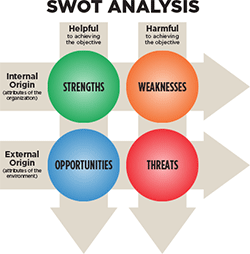Required Reading
First, read through the article titled "Don't Rely On Luck At Work: Define Your Career Aspirations And Goals." Once you've considered the questions presented in the "Don't Rely On Luck" article, read "How To Conduct A Personal SWOT Analysis."
For further guidance, view the video and read the article titled: "Personal SWOT Analysis: Making the Most of Your Talents and Opportunities."
You may have heard of a SWOT analysis before, maybe at your place of employment or with one of the groups you are involved with outside of work. The basic premise and purpose of a SWOT analysis is to assess potential growth and limitations. SWOT is the acronym for Strengths, Weaknesses, Opportunities, and Threats. This SWOT assignment has you turning the lens back on yourself; what are your strengths and weaknesses? What opportunities or threats do you see when looking down the road towards your professional goals?
Part of being successful is understanding what you're good at, what things you need to work on, and what opportunities are available to you. While we all may think we know our strengths and weaknesses, somehow putting them to paper can increase our awareness of them and allow us to address each with confidence. After completing this exercise, you will have a strong answer when you are in an interview, and you get the age-old question, "What are some of your strengths?" or "Tell us about your weaknesses."
Personal SWOT Analysis

| -- | Helpful to Achieving the Objective | Harmful to Achieving the Objective |
|---|---|---|
| Internal Origin (attributes of the Organization) |
Strengths | Weaknesses |
| External Origin (Attributes of the Environment) |
Opportunities | Threats |
Complete a Personal SWOT analysis. You are expected to thoroughly examine your Strengths, Weaknesses, Opportunities, and Threats using the questions at the bottom of the page to help guide you through the process. Once you have identified your strengths and weaknesses, you can then use that information to identify opportunities and threats that may exist in the pursuit of your desired career. An easy way to think of it is this: strengths and weaknesses are directly attributable to you, your personality and your experiences. Opportunities and threats are less personal things that, while you may be able to influence the outcome, you don't necessarily have control over. For example, a strength would be that I have the ability to speak and understand American Sign Language. A weakness would be that I have a tendency to be impatient. An opportunity would be that 40% of the workforce is slated to retire in the next ten years. A threat is that corporate is eliminating duplicate positions in my division. (NOTE: None of this is truth, just random examples I chose in a variety of situations to help you better understand the type of information you should be considering).
Your SWOT analysis should be guided by the questions listed below. Be sure to incorporate any additional information you feel may be useful in presenting the SWOT analysis. You can use a matrix, which may initially help you work through the analysis. You can also incorporate photos and other visuals if you'd like. Be creative and resourceful. Have fun with this!
NOTE: Feel free to do your own search if you still are unclear about the purpose and implementation of this activity. There are many great resources available to you.
| STRENGTHS |
|
|---|---|
|
WEAKNESSES |
|
| OPPORTUNITIES |
|
| THREATS |
|
| ADDITIONAL QUESTIONS |
|
Activity
Present your SWOT analysis as a narrated PowerPoint, Prezi, or product of any other presentation-type of software. You do not need to personally appear throughout the video, but your voice must be used to talk through and discuss the SWOT analysis findings. You may choose a recording technology and format that best suits your skills and equipment. Please show the SWOT matrix you've completed.
For some helpful tips on creating a presentation, visit the Creating a Presentation. You can also access LinkedIn.com/learning for help with PowerPoint if you need it. You have access to this resource with your Penn State credentials.
Grading
The SWOT analysis will be graded using a detailed rubric that can be found in Canvas.
Submission
Upload your file to the "SWOT Analysis" Dropbox in Canvas by the date specified.
